Thirty Years On
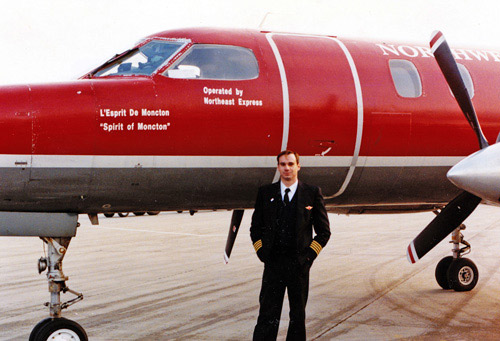
The author and the “Spirit of Moncton,” in 1994.
August 28, 2020
HOW LONG have you been a pilot?
I’m never sure how to answer that question. I had my private pilot’s license at nineteen, but is that the proper benchmark? For a number of years after that, building time as an instructor, I flew nothing bigger than a single-engine four-seater. Define “pilot,” I guess.
What most people are getting at, I think, is how long I’ve been an airline pilot. And the answer to that one is easy: thirty years. Thirty years to the day, in fact. There couldn’t be a worse time for the marking of such a milestone, what with the entire industry bleeding at the jugular. But that’s aviation for you. In this weird business, the forces that shape your career are usually those beyond your control.
And here we are.
I vividly remember “the call.” Nowadays it’s more likely to be a letter, or an email, but in those days it was always a call. It was the summer of 1990, and I remember the phone ringing. I remember standing in the kitchen of the house I grew up in, where I still lived at the time, and picking up the receiver, hoping it was the airline at the other end. And I can recall, pretty much verbatim, the entire conversation between me and a secretary named Vanessa Higgins, as she told me I’d been selected for class. I should report for training on Monday, August 28th, Vanessa explained. The adrenaline rush almost knocked me to the floor.
I date my 30th anniversary not to the moment of that phone call, or to the day, a few months later, when I lifted off the runway with passengers for the first time. To me, it’s the day that I showed up for classroom training, in a rented schoolroom in downtown Bangor, Maine. That was the day I became an employee. Our instructor was a young pilot named Ubi Garcez, who today is a captain for Delta Air Lines. He welcomed us, allowed us to dispense with our neckties, and issued our ID badges, which in those days were little more than pieces of laminated cardboard on which Vanessa had hand-typed our names. My employee number was 421. And typed across the bottom was my date of hire: August 28, 1990 — probably the most significant day of my life, save for my birthday.
The company was an upstart outfit called Northeast Express Regional Airlines. We were one of the feeder affiliates for Northwest. Our planes, painted in red, said “Northwest Airlink” on the side. The company had been started in Maine, and kept its offices there, but its hub was in Boston, where our small turboprops would bring passengers in from outlying cities and connect them to Northwest’s Boeings and Douglases headed around the country and overseas.
This was the shittiest of shitty airlines. The planes were old and working conditions dismal. My starting salary was $850 per month, gross, and my first aircraft, the Beech-99, was a relic from the 1960s. It had no pressurization or autopilot, and most of its instruments and radios were the same ones I’d seen in the cockpits of the Pipers and Cessnas I’d flown as a novice. But none of that mattered. Salary, working conditions — those things meant nothing to me. All that mattered was to be sitting in that room, with that stupid-looking ID clipped to my pocket.
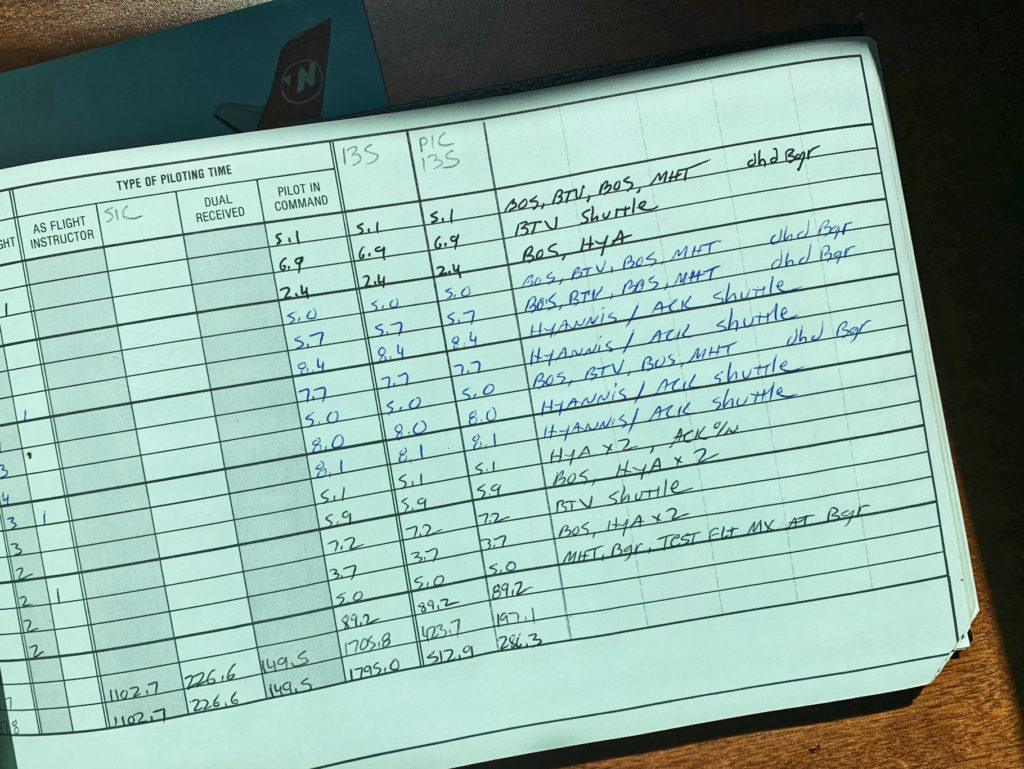
Page from the author’s logbook, 1991.
Pilot jobs in those days were exceptionally competitive. At twenty-four I was the third-youngest in our class of about a dozen. And with 1,600 or so flight hours I was one of the least experienced. I was fortunate to be there at all. I would study the others, wondering where and how I fit in. To this day I remember most of their names and can still hear their accents. One guy had flown business jets, another had flown 727s at Eastern. No, this wasn’t the major leagues. To make a baseball analogy, it was like getting to play for a last-place team at Triple-A in front of about 35 fans. But it was pro ball, so to speak. I’d made it. I was an airline pilot now.
My first “revenue flight,” to use a common if charmless aviation term, didn’t come for another three months. It would take place on October 21, 1990, a date promptly immortalized in yellow highlighter in my logbook. This cherished day involved, among other misfortunes, a drive to Sears at 9:30 in the morning, an hour before my sign-in time, because I’d already lost my tie. (And then the clerk’s face when I told him, “plain black” and “polyester, not silk.”). Then the big moment, in a thickening overcast just before noon, when I would depart on the prestigious Manchester, New Hampshire, to Boston route — a fifteen-minute run frequented, as you’d expect, by Hollywood stars, sheikhs, and dignitaries.
The plane was too tiny for a flight attendant, and I had to close the cabin door myself. Performing this maneuver on my inaugural morning, I turned the handle to secure the latches as trained, deftly and quickly in one smooth motion. What I didn’t see was the popped screw beneath the fitting, across which I would drag all five of my knuckles, cutting myself badly. The door was in the very back, and so I came hobbling up the aisle, stooping to avoid the low ceiling, with my hand wrapped in a bloody napkin.
It was oddly and improbably apropos that my inaugural flight would touch down at Logan International. Airline pilots, especially those new at the game, tend to be migrants, moving from city to city as the tectonics of a seniority list dictate. It’s a rare thing to find yourself operating your very first flight into the airport you grew up with. And I mean that — “grew up with” — in a way that only an airplane nut will understand. As I maneuvered past the Tobin Bridge and along the approach to runway 15R, I squinted toward the parking lot rooftops and the observation deck from which, as a kid, I’d spent so many hours with binoculars. Looking down, I was watching me watch myself, in a sense, celebrating this weird, deeply emotional culmination of nostalgia and accomplishment. If only my hand wasn’t bleeding so much.
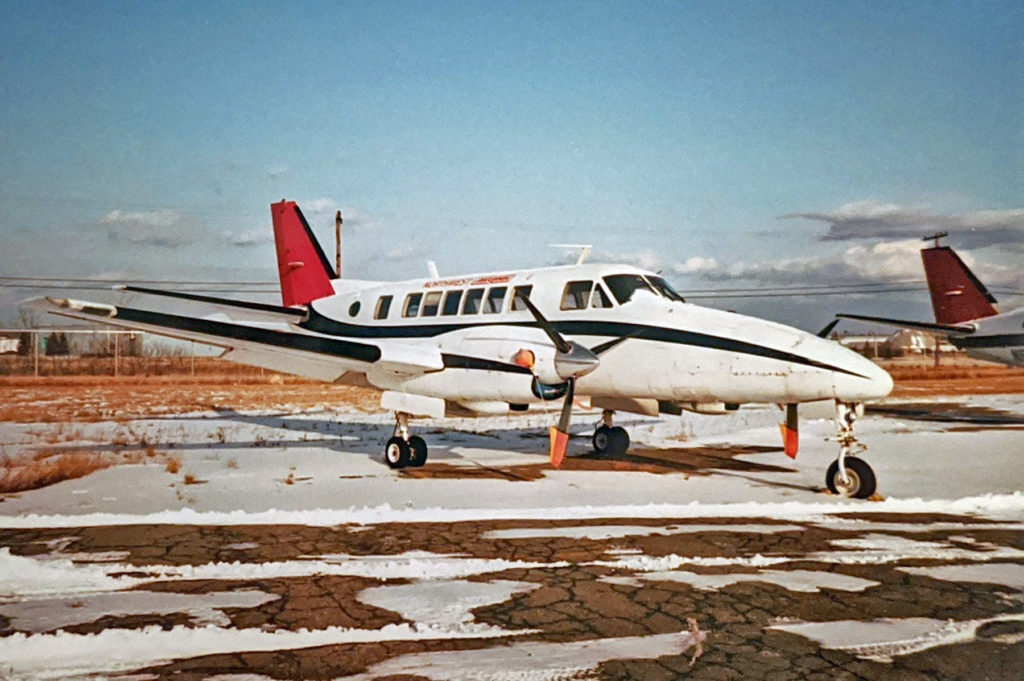
A Beech 99 of Northeast Express.
Noisy and slow, the Beech-99 was a ridiculous anachronism kept in service by a bottom-feeder airline and its tightfisted owner. It had rectangular cabin windows that gave it a vintage, almost antique look, like the windows in a 19th-Century railroad car. Passengers at Logan would show up planeside in a red bus about twice the size of the plane. Expecting a 757, they were dumped at the foot of a fifteen-passenger wagon built during the Age of Aquarius. I’d be stuffing paper towels into the cockpit window frames to keep out the rainwater while businessmen came up the stairs cursing their travel agents. They’d sit, seething, refusing to fasten their seat belts and hollering up to cockpit.
“Let’s go! What are you guys doing?”
“I’m preparing the weight and balance manifest, sir.”
“We’re only going to goddamn Newark! What the hell do you need a manifest for?”
And so on. But this was my dream job, so I could only be so embarrassed. Besides, the twelve grand a year was more than I’d been making as a flight instructor.
In addition to just enough money for groceries and car insurance, my job provided the vicarious thrill of our nominal affiliation with Northwest. Our twenty-five or so little planes, like Northwest’s 747s and DC-10s, were done up handsomely in gray and red. Alas, the association ran no deeper — important later, when the paychecks started bouncing — but for now I would code-share my way to glory. When girls asked which airline I flew for, I would answer “Northwest,” with a borderline degree of honesty.
Our uniforms were surplus from the old Bar Harbor Airlines. The owner, Mr. Caruso, had also been the owner at Bar Harbor, and I suspect he had a garage full of remainders. Bar Harbor had been something of a legendary commuter airline in a parochial, New England sort of way, before finally it was eaten by Lorenzo’s Continental. As a kid in the late ’70s I would sit in the backyard and watch those Bar Harbor turboprops going by, one after another, whirring up over the hills of Eastie and Revere. A dozen years later I was handed a vintage Bar Harbor suit, threadbare at the knees and elbows. The lining of my jacket was safety-pinned in place and looked as if a squirrel had chewed the lapels. Some poor Bar Harbor copilot had worn the thing to shreds, tearing the pockets and getting the shoulders soaked with oil and jet fuel. I’m fairly sure it had never been laundered. Standing with my fellow new-hires in our new (old) outfits for a group picture, we looked like crewmembers you might see stepping from a Bulgarian cargo plane on the apron at Entebbe.

A Metroliner of Northeast Express, 1994.
My second plane was the Fairchild Metroliner, a faster and somewhat more sophisticated machine. It was a long, skinny turboprop that resembled a dragonfly, known for its tight quarters and annoying idiosyncrasies. At the Fairchild factory down in San Antonio, the guys with the pocket protectors had faced a challenge: how to take nineteen passengers and make them as uncomfortable as possible. Answer: stuff them side by side into a 6-foot-diameter tube. Attach a pair of the loudest turbine engines ever made, the Garrett TPE-331, and go easy on the soundproofing. All of this for a mere $2.5 million a copy. As captain of this beastly machine, it was my duty not only to safely deliver passengers to their destinations, but also to hide in shame from those chortling and spewing insults: “Does this thing really fly?” and “Man, who did you piss off?”
The answer to that first question was sort of. The Metroliner was equipped with a pair of minimally functioning ailerons and a control wheel in need of a placard marking it “for decorative purposes only.” It was sluggish and unresponsive, is what I’m saying. Somewhere out there is a retired Fairchild engineer feeling very insulted. He deserves it.
Like the 99, the Metro was too small for a cockpit door, allowing for nineteen backseat drivers whose gazes spent more time glued to the instruments than ours did. One particular pilot, whose identity I’ll leave you to guess, had doctored up one of his chart binders with these prying eyes in mind. On the front cover, in oversized stick-on letters, he’d put the words HOW TO FLY, and would stow the book on the floor in full view of the first few rows. During flight he’d pick it up and flip through the pages, eliciting some hearty laughs — or shrieks.
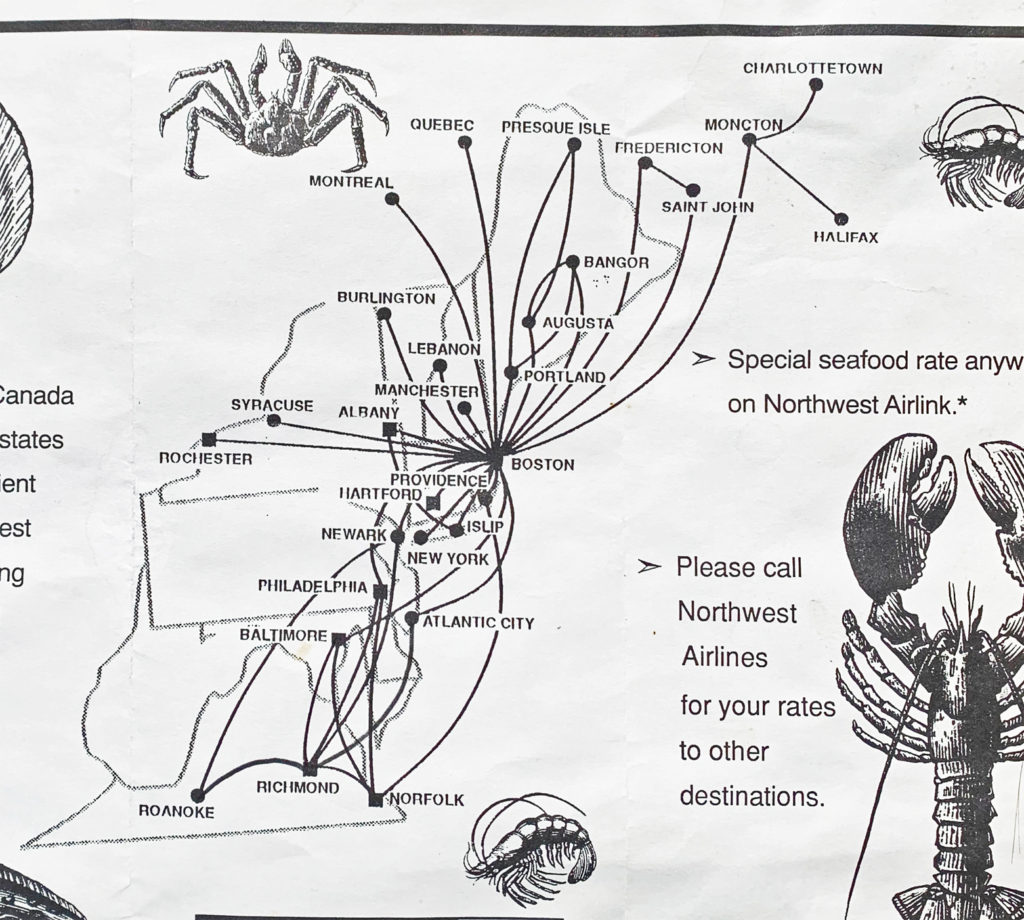
Northeast Express route map, 1994.
In the spring of 1993 I graduated from the Metro to the De Havilland Dash-8. The Dash was a boxy, thirty-seven-passenger turboprop and the biggest thing I’d ever laid my hands on. A new one cost $20 million, and it even had a flight attendant. Only thirteen pilots in the entire company were senior enough to hold a captain’s slot. I was number thirteen. I went for my checkride on July 7th, shortly after my twenty-sixth birthday. For the rest of the summer, I would call the schedulers every morning, begging for overtime. Getting to fly the Dash was a watershed. This was the real thing, an “airliner” in the way the Metro or the 99 could never be, and of all the planes I’ve flown, large or small, it remains my sentimental favorite.
I flew the Dash only briefly, and Northeast Express would be around only for another year. Things began to sour in the spring of ’94. Northwest, unhappy with our reliability, would not renew our contract. We were in bankruptcy by May, and a month later the airline collapsed outright.
The end came on a Monday. I remember that day as vividly as I remember my bloody-knuckle inaugural in New Hampshire four years earlier. No, this wasn’t the collapse of Eastern or Braniff or Pan Am, and I was only twenty-seven, with a whole career ahead of me; still it was heartbreaking — the sight of police cruisers circling our planes, flight attendants crying, and apron workers flinging suitcases into heaps on the tarmac. Thus the bookends of my first airline job were, each in their own way, emotional and unforgettable. That second one, though, I could have done without.
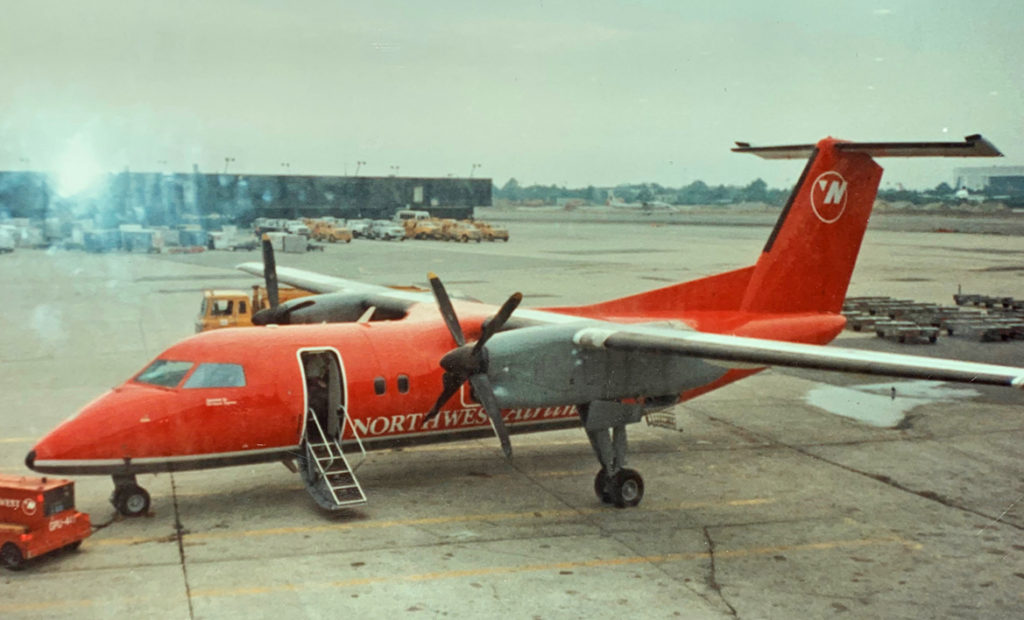
Dash-8 at Kennedy Airport, 1993.
I have only a few mementos from that job. A few scraps of paper, a set of wings, a coffee mug, and a tiny number of poor-quality photos, not one of which, for better or worse, shows the Beech-99.
From that final day at Northeast Express through today, it’s been both an uphill and downhill journey. Many years and five airlines later, I finally made it to the major leagues — to the New York Yankees, as it were, to revisit my baseball analogy. Along the way I’ve endured bankruptcies, multi-year furloughs, and now the COVID-19 debacle that, for all I know at this point, could end the game completely. Highlights, lowlights, life-defining thrills and crushing disappointments, it’s all packed in there.
And it continues. I judge my career as a successful one — I made it further than most pilots do — and it remains a work in progress. However and whenever it reaches its conclusion, at the beginning of it all — and really at the heart of it all — is that first day of class in 1990. Thirty years ago today.





Leave a Comment
Maximum 1500 characters. Watch your spelling and grammar. Poorly written posts will be deleted!
53 Responses to “Thirty Years On”
You are viewing newest comments first. Click to reverse order
Patrick – thank you for this trip down memory lane! I have exactly the same memories and feelings about my years at Mesaba – I could’ve written this story… I flew the Metroliner (lawn dart) and Dash 8, but somehow avoided any furloughs or bankruptcies in my 35 year career. I love the part about comments by the passengers. Being a woman pilot, I had to listen to lots of sexist comments and actually had a couple of Metro passengers try to get off the airplane. One even wondered why the flight attendant sat in the cockpit talking to the pilot during the entire flight. It never bothered me because I had the best job in the world. I am feeling very nostalgic as I’m retiring from my cargo airline in 2 weeks. Although I look forward to keeping my feet on the ground, I still feel lucky to have had such an interesting, rewarding career. And thank you for all of your writing throughout the years!
All this history is absolutely Amazing!
Thanks for sharing with us this wonderful experience.
I think each one fall in love with the Aviation world may find interesting ideas and ispiration by this one.
Thank you very much.Please Take a look about my Aviation Blog Site https://www.mondoaviazione.com
I really appreciate your feedback.
Best Regards for your new articles.
Patrick:
Fascinating. You show how passion can overcome…ANYTHING.
Besides a great personal account, you give a good glimpse into the airline industry. “Multi-year” furloughs? Did they pay you anything in that time?
Your description of the aircraft is similarly vivid and the indignities forced on the pilot in the “puddle jumpers”. But then the wonderful feeling of moving up through the pantheon of planes. Or the dismay of down: that Eastern 727 pilot.
I’m not sure what state-of-the-air airliner(s) you fly now, but I bet there’s times during a long flight when exactly nothing is going on and you can muse on your rise through the ranks to–literally–the stratosphere. All worth it.
The other element in your posts is your great interest in the world, and not just that of the airlines. You show what I mentioned at the beginning here, what always makes things interesting: passion.
Thank you! -cb
It’s hard to believe but a few years later, I was flying a Be-99 (C model) for a whole lot LESS money for a bottom feeder that should’ve changed its name to CATFISH
I was #663, BOS based, and flew with you several times. You were a very competent pilot and a great guy. NE was my second of three “airlines”. Still have my hat, two sets of wings some random daily weather and pilot reports (due at days end), three monthly crew scheduling printouts, some splotchy color photos.
It was a magical time as it was fun to fly into so many cool places – especially the Canadian Maritime region.
Those Metro III planes were… like test pilot school on a daily basis. However, they prepared us well for whatever else may be ahead in aviation (or ANYTHING outside of aviation)
Best to you!
Hello, Captain Patrick. I’ve been a fan of yours and have read your articles longer than I can remember, (go back to the modem days!) and I sincerely complement your writing style….a lot better than many professional scribes. The essay about ‘Into The Sea’ with the skinny goth redhead just cracked me up each time I re-read it. Who of us hasn’t done something death-defying to impress a potential new squeeze?
So I have a simple question: what’s the biggest kite you’ve ever flown? Job-related or otherwise? And what was your experience with it?
Thanks for a lot of entertaining writing on one of my favorite subjects.
Wonderful story, Patrick. Makes me feel for you. Been following you, since I read your book, years ago. It even motivates me to order the 2nd edition. Keep it up.? Len
Great story and brings back memories of the NW Airlink “fleet” at MSP flown by Mesaba. The Saab 340 was like a Cadillac when they got them!
I used to fly between Denver and Casper Wy, in the mid 70’s on a Metroliner. We called it the flying sardine can. I can’t remember the name of the airline, but they had a cooler full of beer just behind the pilots. We were invited to help ourselves anytime during the flight. With afternoon thunderstorms and turbulence there was a lot of beer consumed on board. However, there was no toilet, so it was always a dilemma on how much to drink and when to stop. On landing, some could not wait until they got to the terminal, especially if there was a long walk along the tarmac!
The story of your beginnings as a pilot demonstrates your love of your occupation. Keep it up!
I can tell this story now because Bob B. died about 17 years ago. We graduated from Annandale H.S in the D.C. area in 1958, and we both went to VMI, graduating in 1962 with degrees in physics for him and chemistry for me. I went into the Regular Army for 6.5 years including a tour with the 101st Airborne [there’s no such thing as a perfectly good airplane, so learn to jump], and later a year in Vietnam.
Bob went Air Force and flew 707-based tankers. When he left the A.F, he flew with a number of cargo companies for many years as one after another went out of business or merged.
Owing to the influence of another of our Brother Rats, who shall not be named but started the Arab-American Friendship Council, in the wake if the 1991 Gulf War, Bob had contacts to get a job flying passenger planes for Kuwait Airways, at first out of Kuwait, and at the end of his career, flying the Bangkok-Manila route.
So strange careers in flying seem to be the norm, and I hope you can get back to doing what you love sooner rather than later, and that means a vote for Biden. Trump has no plan beyond the election beyond saving his ass from prosecution.
Patrick, I have been enjoying your storytelling and commentaries for years and am a great admirer of your stylish writing. This piece is a perfect example. It’s poignant, funny and interesting, and it drives home how much I miss flying and travel. We haven’t left our home town since March 2 of last year, when we returned from several months of almost non-stop trips and we won’t be going anywhere until there is a vaccine.
Congratulations on your 30 years, for better or worse.
You sound like a railroader. My career with Chessie/CSX was about the same, long layoff (12 years in the 80’s early 90’s) seniority is all…but I stayed at my home and my home terminal through my career. Went to the big cities in the northern Midwest, Detroit, Flint, Toledo and various points in the Chicago area. And yes, I got to work on the same lines I had watched trains on when I was a kid. I pictured my friends watching us go by, but never saw anyone I knew.
Retired now and don’t even live in an area with trains anymore. I miss the job and the friends I made but NOT the company.
And by the by, I enjoy your stories!
Dan in Michigan.
Wonderful read !
Please continue to bring it forward !
Very enjoyable read. It reminded me of the too-many commuter flights I have taken over the years, including my most memorable. A business trip required a visit to Mayaguez in Western Puerto Rico, so I had to take a small commuter flight both ways. The plane was much like described here, with an open cockpit and about 3-4 seats on each side of the plane. During takeoff for the return to San Juan, we got the speed up, raised the front wheels, and then the pilot loudly said “shit!” and brought the plane to a stop as quickly as possible so we did not run off the runway. Very exciting indeed—-and I had to wait for about 6 hours for another small plane to arrive to complete the trip.
Thanks for sharing the memories! It was quite amusing to read though probably not quite to live through.
Congratulations, Patrick! I enjoy your writing, and this was a fun piece to read. It’s always enjoyable to read something by a professional in his field who is also able to write well, and has the desire and permission to do so. Here’s hoping you’re back in the air soon.
The only constant is change.
Thanks for the memories — yours from the front seats stir mine from the back seats. Not many careers have such great stories.
Good luck and be well.
I started at NorthEast Express on the Metroliner in 1/93 and was there until the end. We flew together several times before you moved to the Dash 8.
I have since also flown the Dash 8 (Q200 & 300) for United Express, the CE680 Sovereign for NetJets and now the Airbus 320 for Frontier.
It is truly like no other industry. In the days of Covid-19, I am so thankful to have a fallback career!
Back in the ‘70s I used to go to Washington State University in Pullman, a long boring 6-hour drive from Seattle. Since my father was a retired UAL pilot I could instead fly Cascade Airlines for the princely sum of $25 each way. Usually this meant flying a Beach 99 or Metroliner so I am quite familiar with both so your article brought back a lot of memories. I never saw any Cascade pilots treated poorly by the passengers as you describe, I find that shocking. You are right about the cramped space of the Metroliner, it was impossible to stand up in the thing and was more than a little claustrophobic.
Great story. As one who never got past the CPL (too busy making children and being an Aerospace nerd) I love reading about this stuff. I have 3 friends who made it to the left seat on the “triple” and I love their stories, too. Also, your writing style is a pleasure to read.
Congrats! I entered the commuter scene about eight years before you. Flew the Metro, DHC Twin Otter… The Twin Otter was a lot of fun, especially without passengers. Yes, we did everything according to the operating manual. Short field takeoffs were the plane’s forte’. Then the B99, Shorts 330 and Dash 7. I ended up as a Check Airman on the ’99. Small catch, no one bothered to tell me until Crew Schedule called one morning. It looked good on the resume’ later on.
You complained about the flying habits of one of the aircraft…Try a Shorts 330! ‘Nuff said. I finished up on the 767 for a “major airline”, as they say.
Congrats on 30 years. I made a midlife career change and am now flying for a regional. I started learning to fly around the same time as you did. I had thought of making a career of it back then, but as the saying goes, life got in the way. Some of my old flying buddies went ahead and started their professional careers at the regionals/commuters, including a couple at NE Express whom you probably knew. While I was still chugging along in Pipers and Cessnas, instructing part time until just before 9/11. Six years ago, after a layoff, I got back in the industry full time. Due to my age, my regional is probably as far as I will go. In spite of everything going on now I don’t regret it for a moment. Thanks for the trip down memory lane.
Brings back memories. I probably worked your flights in EWR, I was technically a Precision airlines employee but we handled both airlines. If flying the 99 and the San Antonio sewerpipe was an adventure, loading them was no better. Although, I have a few hours in the Merlin, the industry had moved on from the smaller turboprops by the time I got my first commuter job.
Scott
I about spit my coffee laughing at your absolutely perfect description of a Fairchild Metroliner. I remember rather un-fondly flying in these things on various business trips for the my first several years out of college in the 80s and 90s, especially for another infamous connector airline in the midwest: Britt Airlines. It was said that any of their airplanes that was on schedule had to be a day late….
Congratulations Patrick.
Hope you’re back in the cockpit soon.
Great article.
Stu
The was a great read and your second-best article. Only the story about your near-miss on your date was better. Ironically, I’m a big Cure fan and love “Into the Sea” (the song is actually called “Lovecats”). Keep up the great writing!
Congratulations and best wishes for many more years in the cockpit, Patrick! A throughly enjoyable read. Hope to fly with you again soon!
Interesting to see the Northeast Express route map from 1994 and to compare it with the state of the regional airline business out of BOS today: no flights to BGR, BTV or even to New Brunswick in Canada.
That’s a good observation. NEX was more of a “commuter” carrier, in the traditional sense, than a “regional” as they’re known today. We fed Northwest’s hub from outlying cities. Regionals today are more surrogates than feeders. They’ve become a method of outsourcing as much as anything else.
Just wanted to add my congrats on 30 years, awesome! I threw in the towel here in Silly-con Valley after 30 years, exhausted and burnt. You’re clearly still raring to go, which I guess you’d need to take the ride you’ve taken. Keep it up and keep writing!
Great piece, quite funny!
Did you ever fly into Bader Field in Atlantic City? I live down the road from there and remember it being an active field when I was younger.
This is definitely one of my favorite articles that you’ve written. You don’t get in to commercial piloting for the money, you get in to it for the passion. The money may or may not come later.
I feel like I should be going on LinkedIn to wish you a happy work anniversary.
30 years, though. Congratulations! That’s very good going.
Happy 30th anniversary, Patrick!
Excellent article, interesting – and nary a typo!
Thoroughly enjoyed this. I wasn’t too far behind you. My forever seniority date is 12/6/93. I was all of 23. I suppose the Jetstream was better than the Beech 99, but I digress. I thought I’d really done something when I transitioned to the SF-340. Alas, I could not have predicted my immune system would turn on my pancreas and I would be diagnosed with Type 1 diabetes just shy of my 26th birthday. And that….as they say….was that as far as commercial flying went. I’ve made the best of it ever since, and congratulations on a successful and interesting career.
Excellent piece, Patrick. We all have such stories, each different but somehow the same. You write yours much better than most. I eagerly await your memoir.
I thoroughly enjoyed this article! I laughed out loud several times. The ‘HOW TO FLY’ anecdote was brilliant. Patrick, I’m grateful you persevered and have been able to educate so many of us about air travel.
My first flight was in the late 70s on a plane that sounds a lot like the Beech-99. While still getting over the shock at the size of the plane, we took off and soon encountered some pretty severe turbulence. Seeking some reassurance, I asked a middle aged businessman across the narrow aisle if this was common. He slowly turned to face me. He was very pale and in a shaky voice said “No”. I spent the next 15 minutes staring at the wing waiting for cracks to develop.
25 years on for me, from Logan airport kid in the late 80s, to little airplanes in Norwood, to Business Express, to “The Yankees”. 9/11, furlough, bankruptcy, some good years, Covid. Quite a ride. Wouldn’t trade it for anything.
Patrick, this is one of your best pieces ever. It took me back in time. I’m a bit older than you, and I was applying for airline pilot jobs at about the same time you were…over and over and over. Somewhere in my attic is a stack of all the “Dear Applicant…best wishes in your future endeavors” letters. I finally burned out at the hiring process and settled into a Part 135 job, along with a lot of hours as an instructor. I know what you mean about the uphill and downhill journey.
Congratulations on your career and accomplishments, and be proud that you succeeded in such a competitive field. And keep on writing!
“This was the shittiest of shitty airlines.”
I nearly spit my coffee out laughing so hard! If you ever write your memoirs, that MUST be the first line:
It was the shittiest of shitty airlines. It was the most important day of my life.
I hope this mess turns around sooner than later. I can’t wait to get back onto a plane myself, as a passenger.
Great piece, Patrick. Thank you.
When I was a kid I wanted this career and was stymied by 20/200 vision. Nobody would hire someone who needed that level of correction.
All the same I am not sure I would have stuck it out with this much dues to pay. Think about it — they planes may be crude and obsolete but they are not only worth millions themselves but also represent a much bigger potential liability if something goes wrong. They put all that in the hands of people making less than what a fast food restaurant manager makes.
$850/month gross in 1990? That was rent or food back then but not both.
Such a thrill to check ask the pilot and find a new piece of patrick‘s poetry. Thank you, and congratulations from LSZH
Great Article!! I enjoyed this piece.
Congrats on 30 years! Reminds me of my first day at Continental Express. You mentioned ‘Bar Harbor’ airlines in the article. Continental Express (later ExpressJet airlines) used the Bar Harbor 121 certificate.
2020 is my 41st year in the railroad industry, which is delightfully and maddeningly similar to yours. The second best day of my railroad career was the day I hired out. The best day was the one I quit that awful job with horrendous hours and pay for a better one. I read your beautifully crafted memory with appreciation and humility. We’ve been very, very lucky, to have had the opportunity to live our dreams, and not get killed doing it. Thank you for making me re-appreciate my good fortune. MWH
That was a great read. Well done!
I enjoyed that piece, the pride shines through!
An early fan of your work (Salon, when it was still readable), I enjoy you very much to this day. Hopefully you have many flights in your future and I have more of your writing in mine.
I’ve been reading you since you started – another great article. All the very best and I hope you have many many more years in the cockpit!
Yes – another example of why people keep coming back to “Ask the Pilot.” Great article. I also hope you fly for many more years!
Great article, Patrick. Very nicely written. And a heartfelt congratulations! Hope you’ll enjoy many more years at that desk up front.